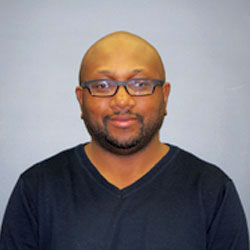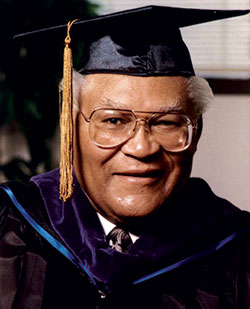Dwayne Mack was, to say the least, skeptical when his faculty mentor at Washington State University, LeRoy Ashby, suggested he write his doctoral dissertation on Spokane’s black history.
“I thought to myself, ‘Wow, every time we pay a visit to Spokane, we rarely even see black people,’” recalls Mack, who was brought up in Brooklyn and received his master’s degree from a historically black college, North Carolina Central University. “There couldn’t be enough black people to do a study.”

Then he started researching Spokane’s African-American history and realized he had “struck gold.” Spokane’s African-American community was small—historically averaging between 1 and 2 percent of Spokane’s population—but it had a rich and compelling story, studded with strong personalities “who were very potent in their approach to civil rights and justice.” The result was a dissertation that earned Mack his doctorate in history at WSU in 2002 and which eventually formed the basis for Mack’s 2014 book, Black Spokane: The Civil Rights Struggle in the Inland Northwest (University of Oklahoma Press), which immediately became the definitive work on the African-American history of the region.
“Most people say there’s strength in numbers, but the black population was so small that this small band of black folk, they stuck together, and they were committed to a cause, along with their white allies,” says Mack, who is now the Carter G. Woodson Chair in African-American History at Berea College in Kentucky.
Their story stretches back to Spokane’s roots. In the 1880s and 1890s, black people were migrating out of the South and spreading across the United States. Hundreds arrived in eastern Washington to work on the railroads, to work in the mines, to work as stonemasons, and, in some cases, to become entrepreneurs. Peter Barrow Sr. arrived in 1889 from Mississippi, established an irrigated apple orchard north of Spokane, and hired more than 100 African-American workers. He then helped establish Calvary Baptist Church, the city’s first African-American Baptist church, and became its pastor. In 1888, Emmett Hercules Holmes brought his family to Spokane from Mississippi and found work as a railroad porter, bellhop, and butler—and eventually became Spokane County’s deputy treasurer. In 1890, he established the Bethel African Methodist Episcopal Church. These two churches would become the twin centers of Spokane’s small black community, and their pastors would become the community’s earliest activists. When a business put up a “No Colored Patronage Solicited” sign, the pastors were the ones who would pay a visit and respectfully request its removal. Sometimes they got results, sometimes they didn’t.
Spokane had a West Coast form of Jim Crow, but it wasn’t as blatant as Jim Crow in the South. “Here, you didn’t have lynchings or people being chased out by the Klan,” says Mack. “But you did have store owners who put signs on the windows and shop-owners who wouldn’t let them try on clothes, and barbers who would not cut black hair.” The black community’s options were especially limited in labor and housing. “For the most part, blacks found menial labor positions. You had black entrepreneurs, a handful, but for the most part, blacks worked as domestics and chauffeurs and butlers.”
No true “black ghetto” emerged in Spokane as it did in cities such as Los Angeles and Oakland. Black residents were restricted by covenant and custom from the South Hill, the most posh part of Spokane, yet for the most part, black residents were scattered around the city. “Because they were no real threat, blacks were able to survive and coexist with white people,” says Mack.
In 1919, 81 petitioners submitted an application to create one of the community’s enduring institutions, the Spokane chapter of the National Association for the Advancement of Colored People (NAACP). Nearly a century later, Jon Stewart of The Daily Show earned a big laugh during the 2015 Rachel Dolezal controversy by saying with feigned astonishment, “Whaaaat? There’s an NAACP chapter—in Spokane?”
The answer has been “yes” for the last 96 years. In fact, the Spokane NAACP’s influence was uncommonly large, at least geographically, since it was the only chapter in a vast area. “It not only mediated and protected the rights of blacks in Spokane, but it also protected the rights of black people throughout the Inland Northwest region, which was socially and culturally isolated,” says Mack. “So if something was happening at a base in Walla Walla in 1945 with black soldiers who were being discriminated against, the NAACP in Spokane would come to their rescue. … East of the Cascade Mountains, Spokane was the only organization you could trust to come to your assistance.”
Spokane’s black population ticked upward in the decades following World War II and a new set of community leaders emerged. These leaders form the compelling core of Spokane’s black history. Here’s a look at a few of them:
Carl Maxey

Brought up in a Spokane orphanage, Maxey became an NCAA boxing champion at Gonzaga University and the first African American to pass the bar exam in eastern Washington in 1951. He launched a controversial career as one of Washington’s most effective civil rights attorneys and civic gadflies. Maxey confronted restaurants, hotels, social clubs, and real estate organizations throughout the state and pushed them to end blatant discrimination. He spent the violent Freedom Summer of 1964 in Mississippi as a volunteer lawyer. He also made national news in many high-profile cases, including one known as the “Haircut Uproar,” in which a Gonzaga University student from Liberia was refused service at a barbershop. “The eyes of the world are on Spokane and a small barbershop,” thundered Maxey. “But the issue is not small.” He won that case, and many other civil rights cases. Mack calls Maxey “the Inland Northwest’s version of Martin Luther King Jr.—a true advocate for civil rights.”
James and Eleanor Chase

When Spokane elected James Chase as its mayor in 1981, his supporters called it “a night of history.” Indeed it was, says Mack. “Nine years before Norm Rice was elected mayor of Seattle, you had James Chase, with just a high school diploma, elected mayor of this conservative city. It was a remarkable and amazing accomplishment.” Ebony magazine came to Spokane to do a feature story, in which it noted “that there is a black man who became mayor of a sizable city with little fanfare, no rancor.” Chase arrived in Spokane on a boxcar in 1934, built up an auto repair business, and became the president of the Spokane NAACP. He and his wife Eleanor Chase became deeply involved in civic affairs. After his landslide mayoral victory, he proved to be an exceptionally popular mayor and would have easily been reelected to a second term if he hadn’t dropped out because of terminal illness. Mack calls Chase’s tenure a “watershed moment in the history of black Spokane.”
James and Lydia Sims

James Sims arrived from New Jersey in 1955 and became pastor of New Hope Baptist Church. He and his wife Lydia soon became two of Spokane’s most influential advocates for civil rights. James Sims was elected the Spokane NAACP president in 1956 and Lydia Sims became the first woman to be elected as the chapter’s president in 1976. She had already served as the city’s first affirmative action head, and she brought with her, in Mack’s words, “a sense of tempered militancy.” Among her accomplishments was an annual NAACP job fair, in which she tried to improve black employment opportunities. It was apparent, she said, “that change will not come from the goodness of people’s hearts,” but from moral and legal pressure on employers.
James and Lydia Sims also contributed to the state’s political future in a more personal way. Their Spokane-born son, Ron Sims, was twice elected county executive of the state’s largest county, King County. In 2009, President Barack Obama appointed Ron Sims deputy secretary of the U.S. Department of Housing and Urban Development, where he served until 2011. He currently sits on the WSU Board of Regents.
Mack’s six years as a WSU graduate student prepared him well to tell this story. “Even though I was the only African-American Ph.D. student at the time, the campus community welcomed my family with open arms. I had great advisors, great role models, who took me in and treated me with great respect,” says Mack. “These older men, older white men, just embraced us. … It was a wonderful experience and I wouldn’t change it for the world.”
Mack is doing his best to pass it on. He has developed an expertise in academic mentoring and he recently published two books, Beginning a Career in Academia: A Guide for Graduate Students of Color (Routledge) and Mentoring Faculty of Color (McFarland).
His time in Pullman also proved invaluable in another way. Pullman was considerably less diverse than his hometown of Brooklyn, and looking back, he says, Pullman prepared him to work in a community like Spokane, with a much larger white population. As Mack soon discovered, Spokane’s history came in deeper shades.
